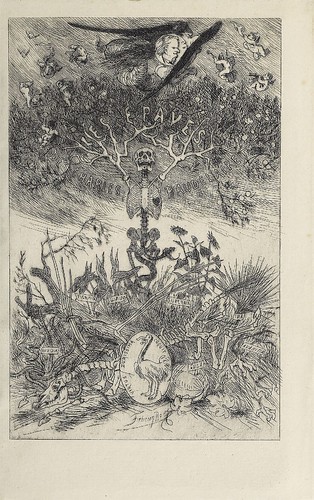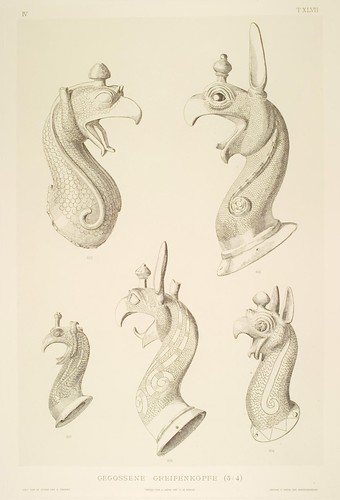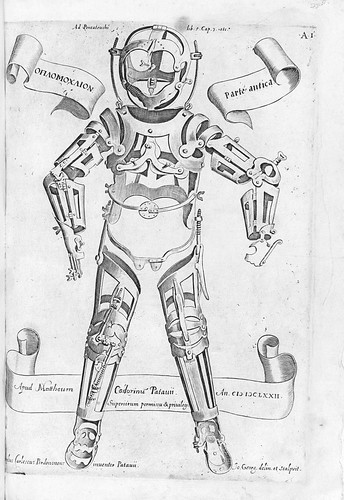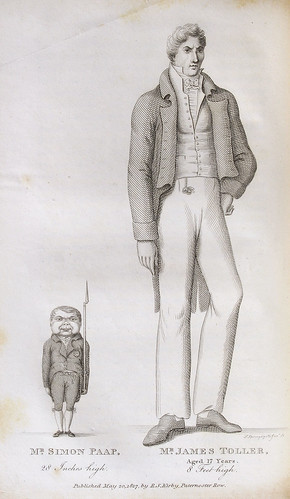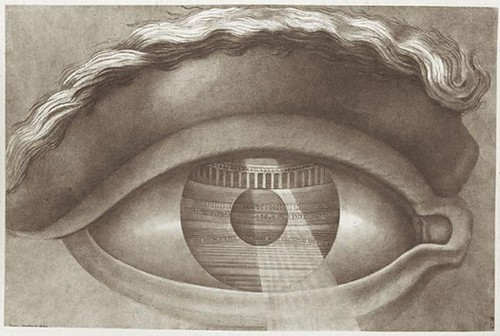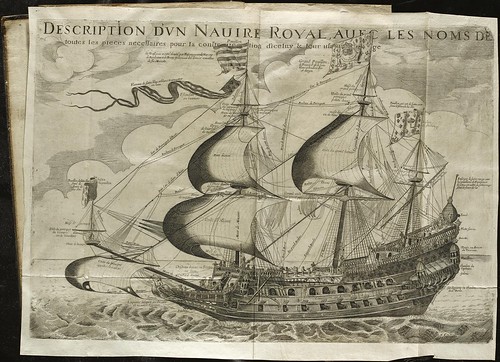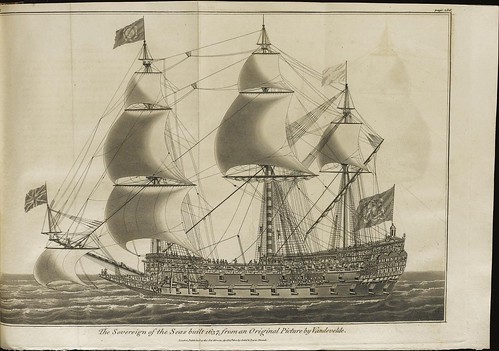Winnie the Pooh [Lot]
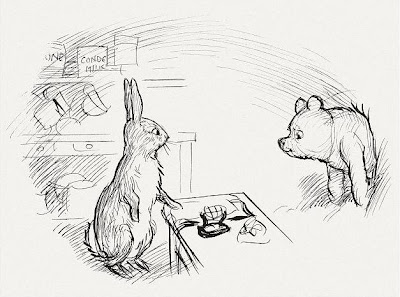
"Pooh pushed and pushed and pushed his way through the hole..."
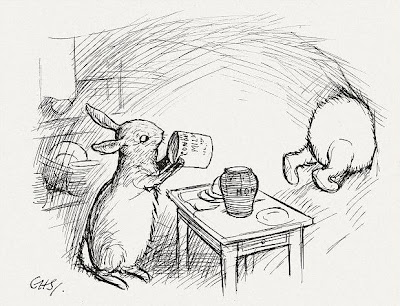
"Oh, help!" said Pooh. "I'd better go back."
"Oh, bother!" said Pooh. "I shall have to go on."
"I can't do either!" said Pooh. "Oh, help and bother!" [Lot]
"Oh, bother!" said Pooh. "I shall have to go on."
"I can't do either!" said Pooh. "Oh, help and bother!" [Lot]
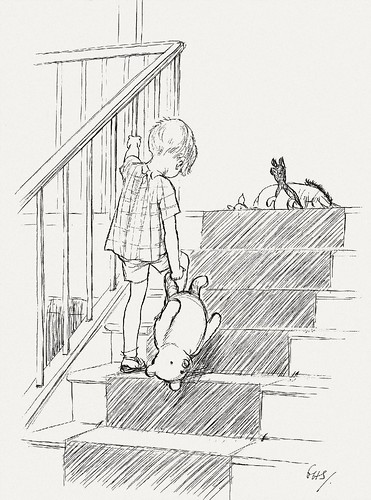
He nodded and went out ...and in a moment I heard Winnie-the-Pooh
– bump, bump, bump – going up the stairs behind him." [Lot]
– bump, bump, bump – going up the stairs behind him." [Lot]
"This original illustration is reproduced on page 159 of Winnie-the-Pooh and comprises a full-page illustration in the published volume. It represents one of the iconic images of Winnie-the-Pooh and comes from the final chapter in which Christopher Robin gives a Pooh party, and we say good-bye.
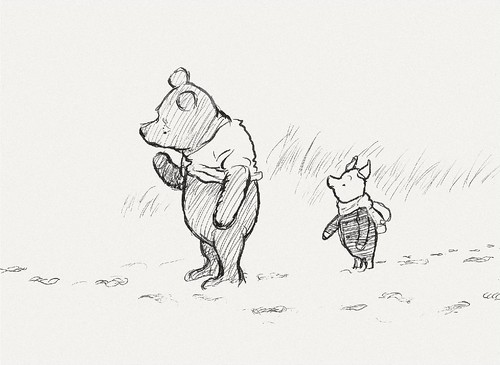
..."What do you see there?"
"Tracks," said Piglet. "Paw-marks..."
Oh, Pooh! Do you thinks it's a – a – a Woozle?"
"Tracks," said Piglet. "Paw-marks..."
Oh, Pooh! Do you thinks it's a – a – a Woozle?"
"This original illustration is reproduced on page 34 of Winnie-the-Pooh from the chapter in which Pooh and Piglet go hunting and nearly catch a woozle. This is the first drawing in the sequence of hunting illustrations." [Lot]
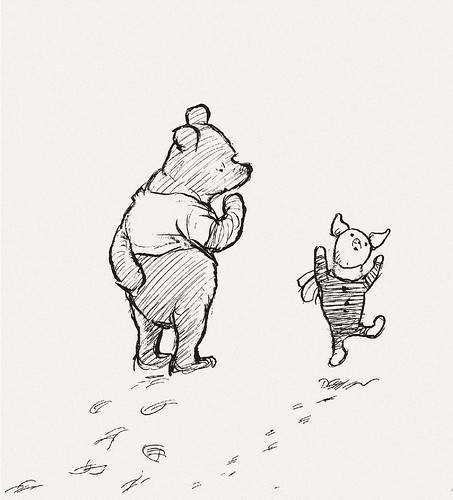
"What?" said Piglet, with a jump.
"This original illustration is reproduced on page 37 of Winnie-the-Pooh. It is from the chapter in which Pooh and Piglet go hunting and nearly catch a woozle. It is the third drawing in the sequence of hunting illustrations." [Lot]
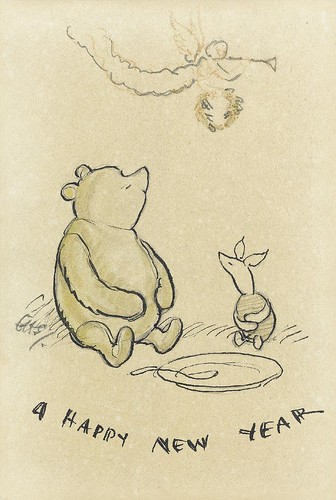
A Happy New Year [Lot]
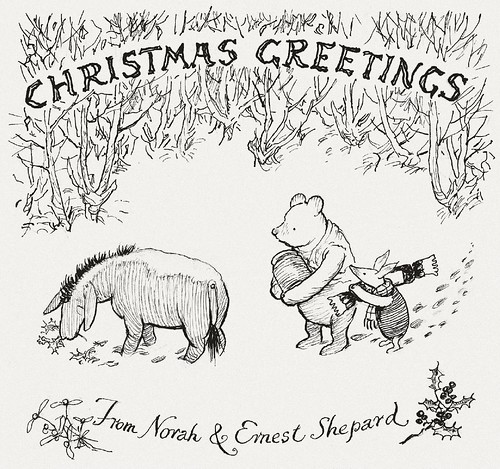
Christmas Greetings
"This illustration of Eeyore with holly, Pooh with a jar of honey and Piglet with a Christmas cracker comprises the original illustration for the only known Christmas card created by E.H. Shepard featuring the A.A. Milne characters." [Lot]
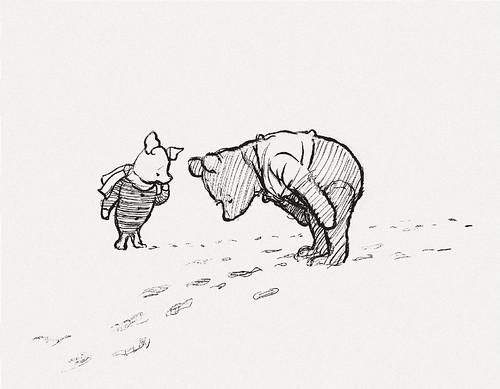
"Do You See Piglet? Look At Their Tracks!"
"This original illustration is reproduced (at a different angle to the original) on page 38 of Winnie-the-Pooh. It is from the chapter in which Pooh and Piglet go hunting and nearly catch a woozle. It is the fourth and final drawing in the sequence of hunting illustrations." [Lot]

"...there was a little left at the very bottom of the jar,
and he pushed his head right in..."
and he pushed his head right in..."
"This original illustration is reproduced on page 64 of Winnie-the-Pooh. It is from the chapter in which Piglet meets a Heffalump.
The reverse of the drawing includes a note that this drawing was given by Shepard's daughter as a gift in 1974." [Lot]
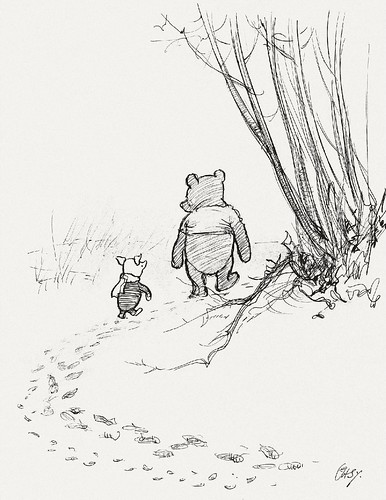
"With these few words he went on tracking, and Piglet,
after watching him for a minute or two, ran after him..."
after watching him for a minute or two, ran after him..."
"This original illustration is reproduced on page 35 of Winnie-the-Pooh and comprises a full-page illustration in the published volume. It is from the chapter in which Pooh and Piglet go hunting and nearly catch a woozle. It is the second drawing in the sequence of hunting illustrations." [Lot]
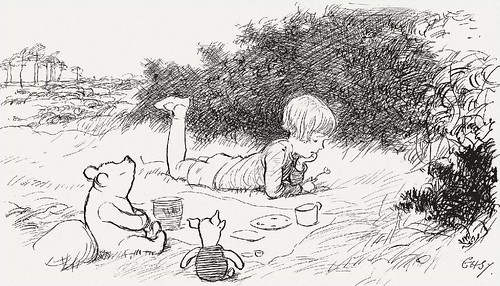
"...Christopher Robin finished the mouthful he was eating
and said carelessly: "I saw a Heffalump to-day, Piglet."
and said carelessly: "I saw a Heffalump to-day, Piglet."
"This original illustration is reproduced on page 55 of Winnie-the-Pooh. It is from the chapter in which Piglet meets a Heffalump." [Lot]
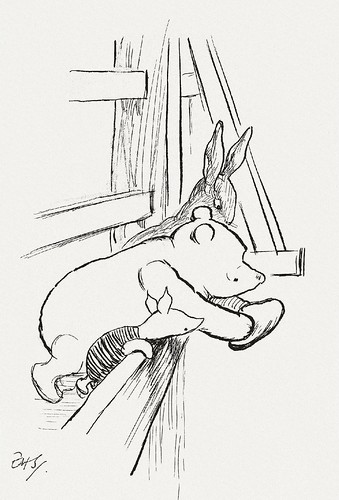
"I'm not throwing it, I'm dropping it Eeyore."
{"Pooh had got the biggest stone he could carry, and was leaning over the bridge, holding it in his paws."}
"This original illustration was reproduced on page 98 of The House at Pooh Corner and is from the chapter in which Pooh invents the game of Poohsticks. At this point Eeyore had fallen into the river and Pooh, Piglet and Rabbit were attempting to make waves to wash him to the bank." [Lot]
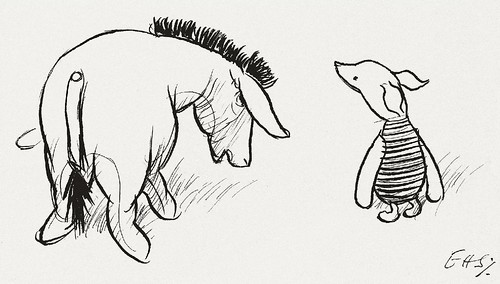
"Just the house for owl. Don't you think so, little Piglet?"
"This original illustration was reproduced on page 159 of The House at Pooh Corner and is from the chapter in which Eeyore finds the Wolery and Owl moves into it. It shows Eeyore suggesting to Piglet that Piglet's house, the "Wolery", would be a perfect new home for Owl."

"Lucky we know the forest so well or we might get lost." [Lot]
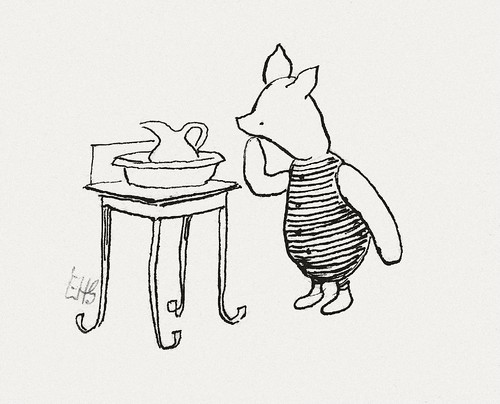
Piglet gets ready for the party.
"This Shepard drawing is a later version of that reproduced on page 149 of Winnie-the-Pooh from the final chapter of the book in which Christopher Robin gives a Pooh party." [Lot]

The Bath
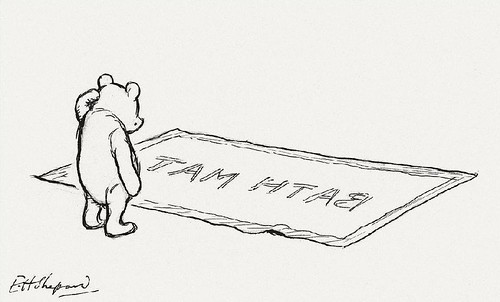
The Bathmat
Christopher Robin gave a deep sigh... At the door he
turned and said, "Coming to see me have my bath?"
turned and said, "Coming to see me have my bath?"
"These original illustrations are reproduced on pages 19 and viii respectively of Winnie-the-Pooh." [Lot]
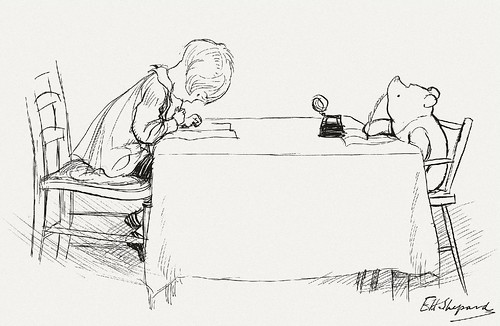
The Friend
"When offered at auction in May 1998 it was noted that a previous owner had typed the verse 'The Friend' (from Now We Are Six) and attached it to the back of the original frame (now destroyed). That poem notes that 'lots and lots of people... are always asking things' and Winnie-the-Pooh is a companion or confidant when confronted with these general knowledge questions. The published illustration shows Christopher Robin with Winnie-the-Pooh and, probably, a writing slate.
The idea of friendship through letter-writing is therefore not present in the poem and the illustration offered here may comprise an earlier illustration before Shepard had read Milne's verse." [Lot]
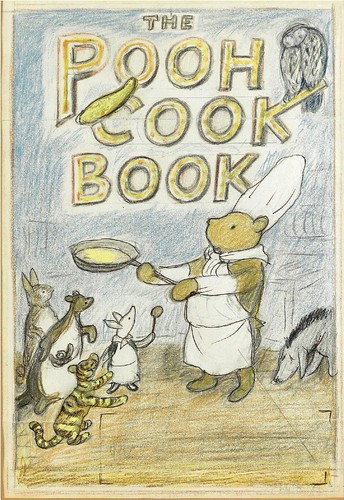
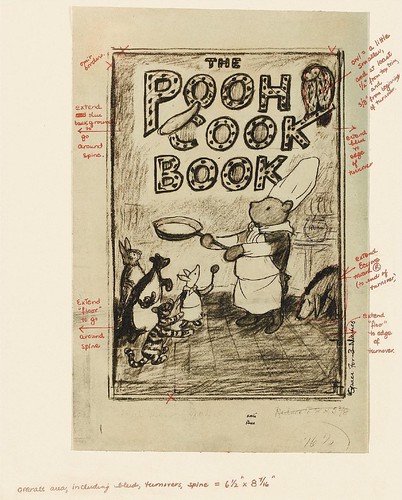
The Pooh Cook Book Preparatory Sketch(es)
"This preparatory sketch includes the reverse of the leaf prepared with pencil rubbing for transfer of outlines. The Pooh Cook Book, "inspired by" the A.A. Milne stories was written by Katie Stewart and published by Methuen in 1971. It was later renamed The Pooh Corner Cook Book." [Lot]
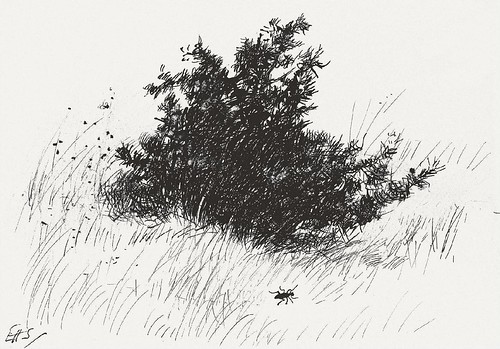
Very Small Beetle exercising round a gorse-bush
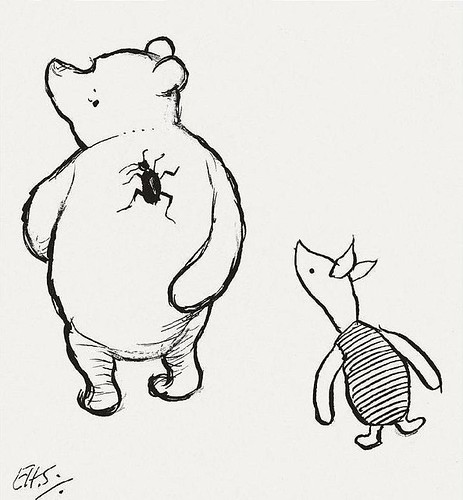
"Pooh!" he cried. "There's something climbing up your back."
"These original illustrations are reproduced on pages 52 and 47 respectively of The House at Pooh Corner. They both come from the chapter in which a search for Small is 'organdized'." [Lot]
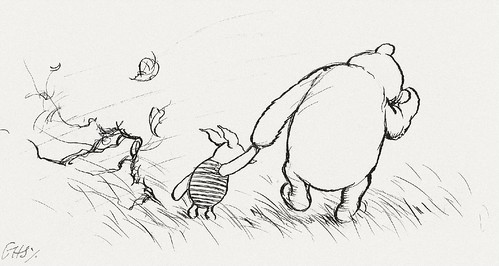
"..then they went on to Kanga's house, holding on to each other.."
"This original illustration was reproduced on page 129 of The House at Pooh Corner and is from the chapter in which Piglet does a very grand thing. It shows Pooh and Piglet walking against the wind on the way to Kanga's house." [Lot]
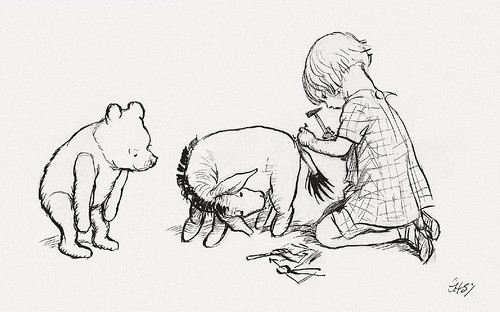
"...and when Christopher Robin had nailed it on in its
right place again, Eeyore frisked about the forest..."
right place again, Eeyore frisked about the forest..."
"This original illustration is reproduced on page 52 of Winnie-the-Pooh. It is from the chapter in which Eeyore loses a tail and Pooh finds one." [Lot]
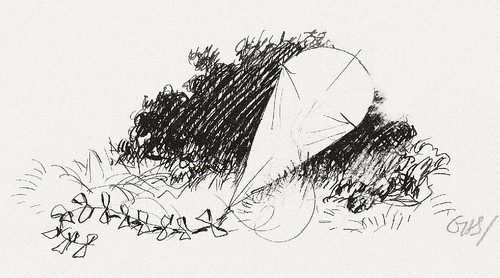
Tailpiece illustration to AA Milne's 'Wind on the Hill'
"...But if I stopped holding
The string of my kite,
It would blow with the wind
For a day and a night..." [Lot]
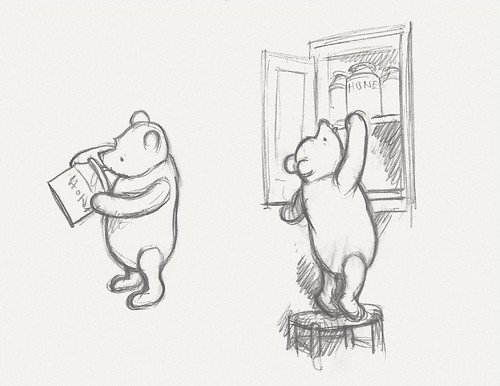
"As soon as he got home, he went to the larder; and he stood on a
chair, and took down a very large jar of honey from the top shelf."
chair, and took down a very large jar of honey from the top shelf."
"These preparatory sketches reveal Shepard's typical working practice with the reverse of the leaf prepared with pencil rubbing for transfer of outlines. The images show some heavy pencil markings where Shepard has heavily pressed down on his pencil for the process. The images are early since the spelling of Hunny has not yet been adopted within the illustration." [Lot]
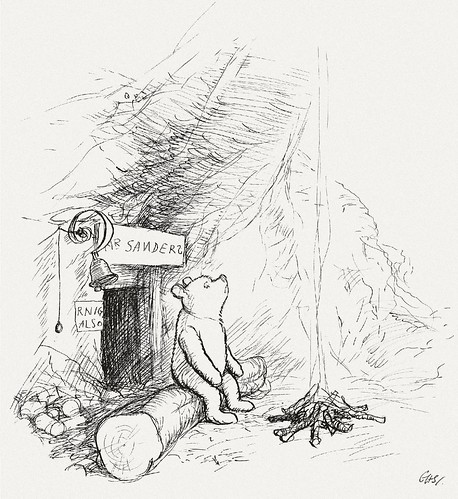
"...Winnie-the-Pooh lived in a forest all by himself under the name of Sanders.
"What does 'under the name' mean?" asked Christopher Robin.
"It means he had the name over the door in gold letters, and lived under it..."
"What does 'under the name' mean?" asked Christopher Robin.
"It means he had the name over the door in gold letters, and lived under it..."
"This original illustration is reproduced on page 3 of Winnie-the-Pooh and therefore accompanies the chapter in which Winnie-the-Pooh is first introduced." [Lot]
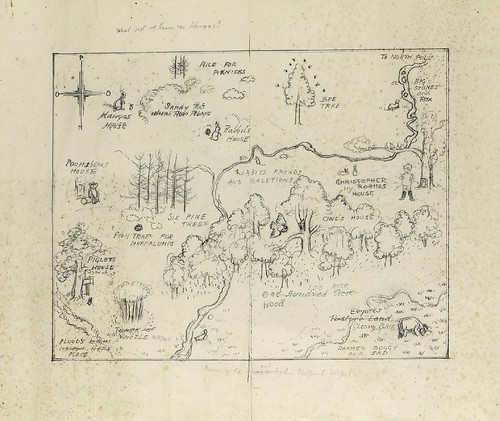
Preparatory sketch-map for endpapers of Winnie the Pooh.
"This is a preparatory drawing for the sketch-map reproduced on the endpapers of Winnie-the-Pooh and therefore one of the most celebrated locations in children's literature. Although the geography was not revised, several captions were evidently changed. 'Eeyores Gloomy Place' was originally 'Eeyores Pasture Land' and the 'Floody Place' was originally captioned 'Floods Might Happen Here'. Shepard also poses the question 'What sort of House is Kangas?' at the top of the map. The caption at the foot originally appeared as 'Drawn by Me helped by Mr Shepard' and shows a process of revision to 'Drawn by Me and Mr Shepard helped'. It was printed as 'Drawn by Me and Mr Shepard helpd'." [Lot]

(A version of-) 'Tiggers don't like Honey'
Oval pencil drawing of Winnie-the-Pooh, Tigger and Piglet sold on November 4, 2008 for £31200.[click on any image - except the last - for a larger version]
All illustrations are by EH Shepard. {It is more probable than likely that they remain protected by copyright although I'm not sure I can determine just who (or which entity) owns those rights; nor am I sure what the extent of those rights might be. Suffice it to say that I accept that a variety of entities have a potential interest, and it is possible that this post may be removed if valid objections are raised. A wise man once told me that regions of universal harmony can be generated within the confluence of homage, fair use and free publicity, however. I'm banking on his having been sober at the time.}
These delightful illustrations are from the Sotheby's catalogue - click 'browse catalogue' - pertaining to the auction of forty two items, 'That sort of Bear': E.H. Shepard's Winnie-the-Pooh From the Collections of Stanley J Seeger and Christopher Cone, which will be held at New Bond Street in London on 17th December, 2008.
Ernest Howard Shepard (1879-1976) was born in London and encouraged to draw from a young age by his artist mother. He won a scholarship to the Royal Academy at the age of eighteen.
In the early years of the 20th century Shepard achieved some success with illustrated editions of Dickens and Aesop's fables. By 1907, Punch Magazine had accepted some of his drawings for publication although he wasn't a permanent Punch employee until 1921. He would remain there for more than thirty years.
In WWI, Shepard earned a Military Cross for bravery during service with the Royal Artillery in France and Belgium but he continued to sketch humorous vignettes which he submitted to Punch. In the 1920s, he was introduced to Alan (AA) Milne who reluctantly commissioned Shepard to do some line drawings for a children's book he had written. And the rest, as they say, is history.
Shepard and Milne were never particularly close but their collaboration on the four books - 'When We Were Very Young' (1924); 'Winnie the Pooh' (1926); 'Now We Are Six' (1927) and 'The House at Pooh Corner' (1928) - ensured that their names would be associated for eternity. Characters included Christopher Robin, Winnie the Pooh, Tigger, Eeyore, Piglet, Owl, Rabbit and Kanga.
The character of Winnie the Pooh was based on Milne's son's (Christopher) teddy bear, but the drawings were inspired by a toy bear named Growler, belonging to Shepard's own son. Growler would be mauled to death by a neighbour's dog, but Christopher's bear (and other stuffed Winnie the Pooh animals) circuitously made their way to the New York Public Library where I believe they still live. Late in life, Shepard was said to have voiced some resentment that the "silly old bear" had overshadowed his other illustration work, but he had expressed his fondness for the characters on many more occasions, so this phrase may have been more affectionate than has been reported*.
Although he pursued book and magazine illustration all through his life, Shepard's most notable work, beyond the AA Milne quartet, were the line drawings he produced for Kenneth Grahame's 'The Wind in the Willows', published in 1931.
I have taken the liberty of cleaning up all the images above (except for the map) which may have included removing some original ink splatters and charcoal or pencil smudging. Nothing too drastic, but they look better this way. I was surprised to find myself smiling often during the process. These simple line drawings retain an innocent magic about them and bring back fond childhood memories. There are a couple more drawings in the flickr set not seen above.
- Amazon:☼☼ 'When We Were Very Young' ☼☼ 'Winnie the Pooh' ☼☼ 'Now We Are Six' ☼☼ 'The House at Pooh Corner' ☼☼
- Biographies: one; two; three {wiki}.
- The Adventures of the Real Winnie-the-Pooh at NYPL.
- A Short History of Pooh and Winnie by Peter Dennis.
- 'Winnie-the-Pooh at Sotheby's - Colin Gleadell on a bear of very substantial value' {UK Telegraph}
- AA Milne & Winnie the Pooh at Wikipedia.
- 'The Original Wind in the Willows' exhibition site at the Bodleian Library, Oxford University.
- Previously: Beatrix Potter Rarities / kids.
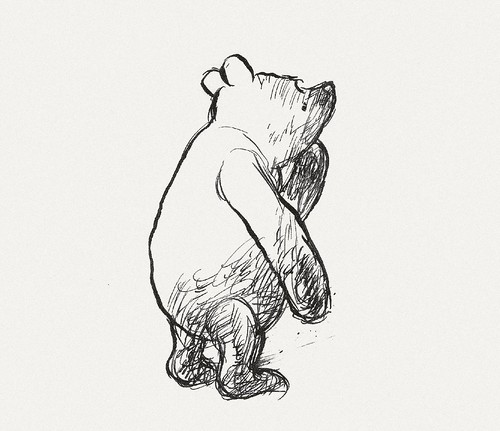
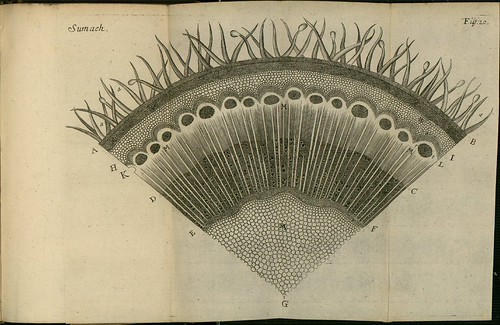
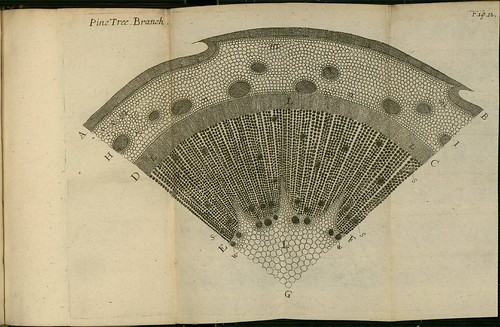

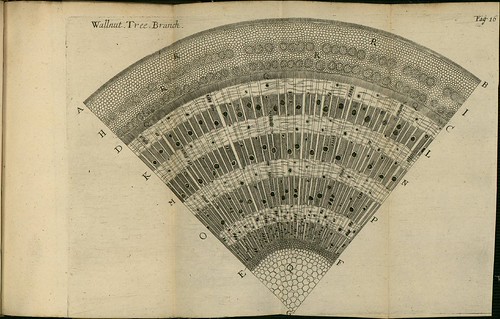
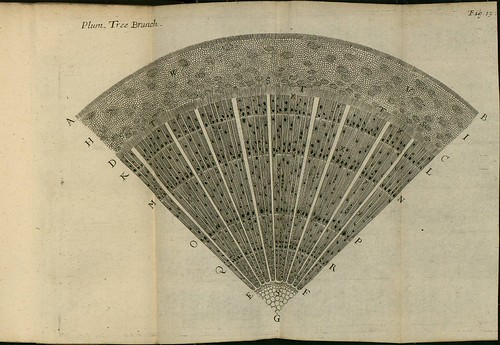


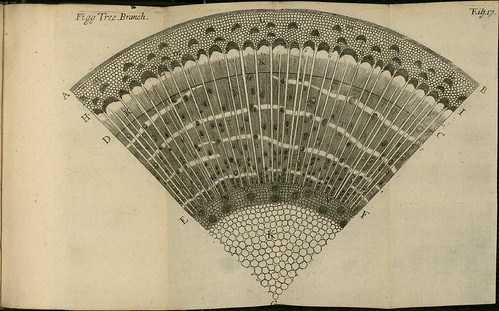

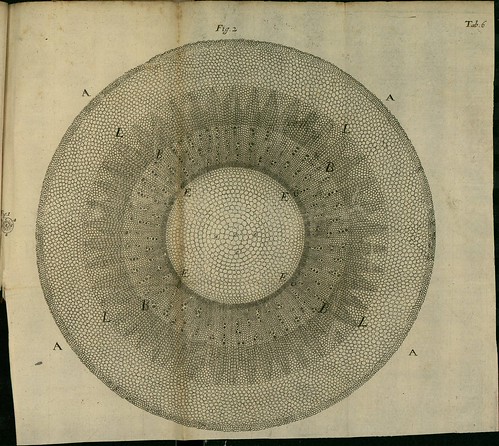
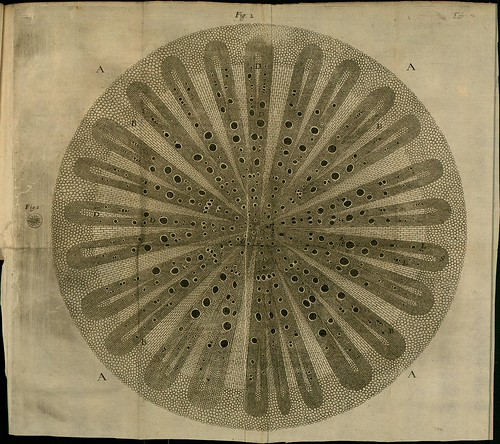


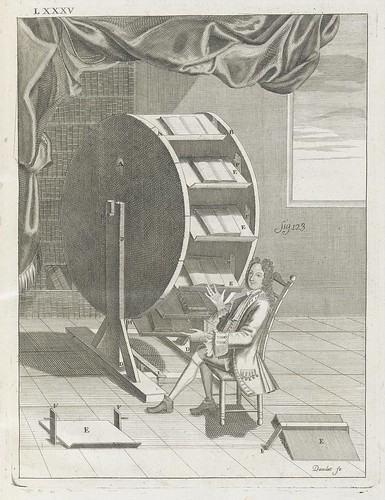


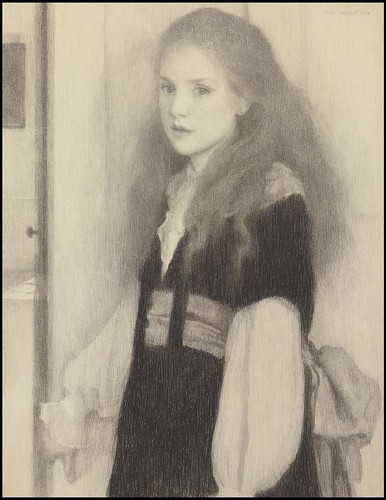
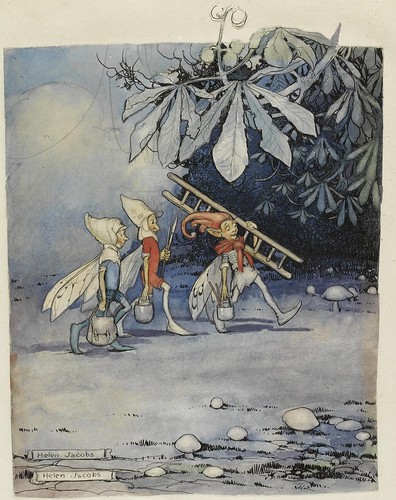
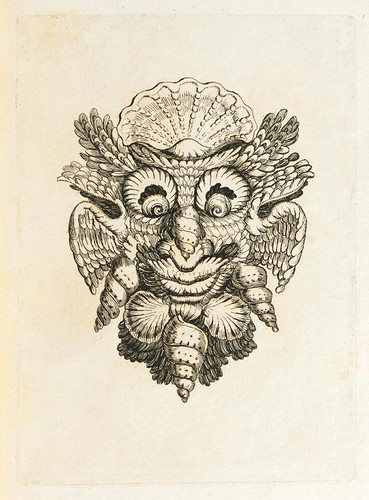
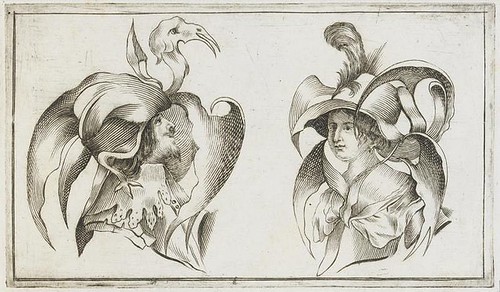


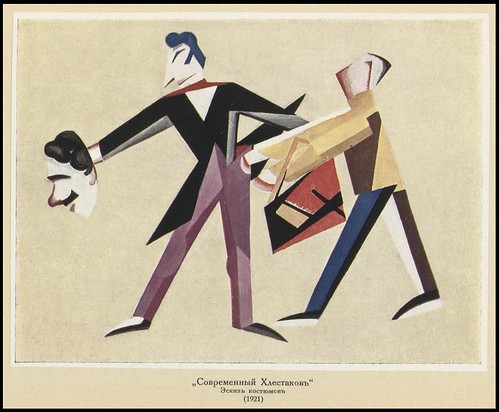


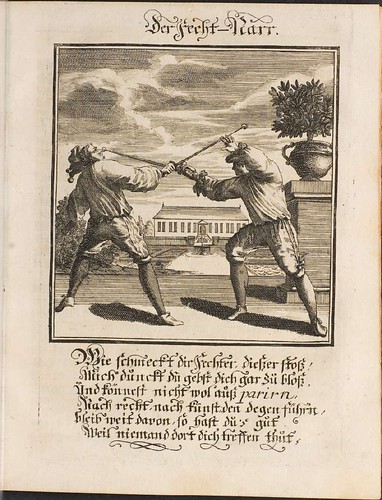

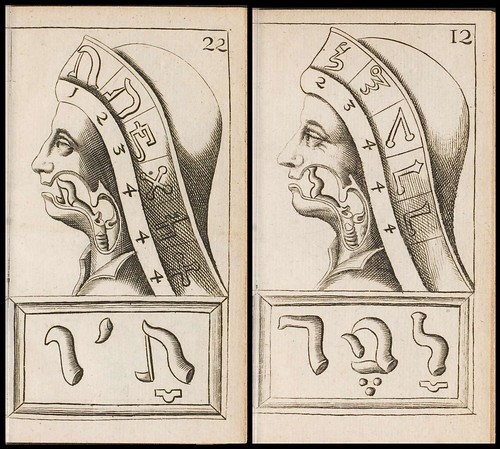
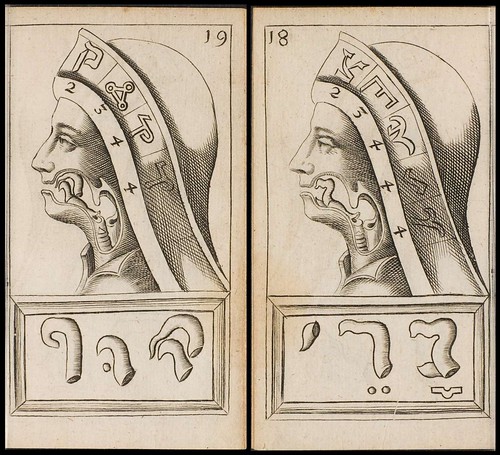
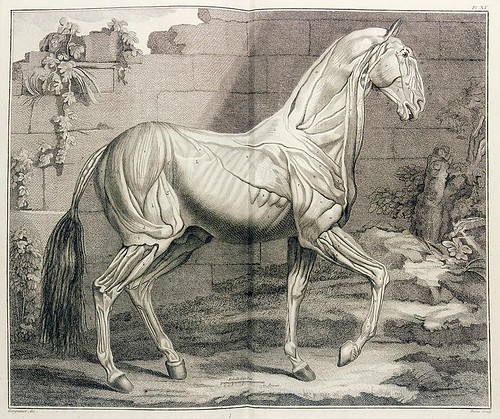
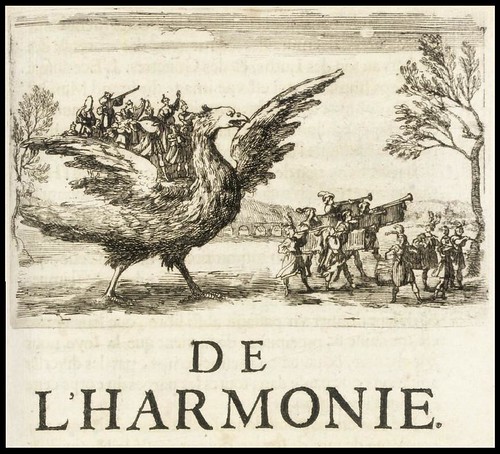
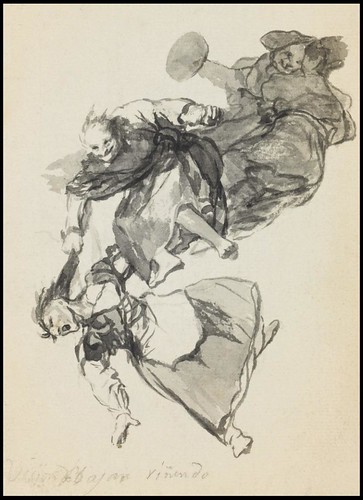
![Aleksei Kruchenykh 'Na Bor''bu s Khuliganstvom v Literaturie' [Against Hooliganism in Literature] 1926](http://farm4.static.flickr.com/3035/3050830778_38a5fae5ef.jpg)
